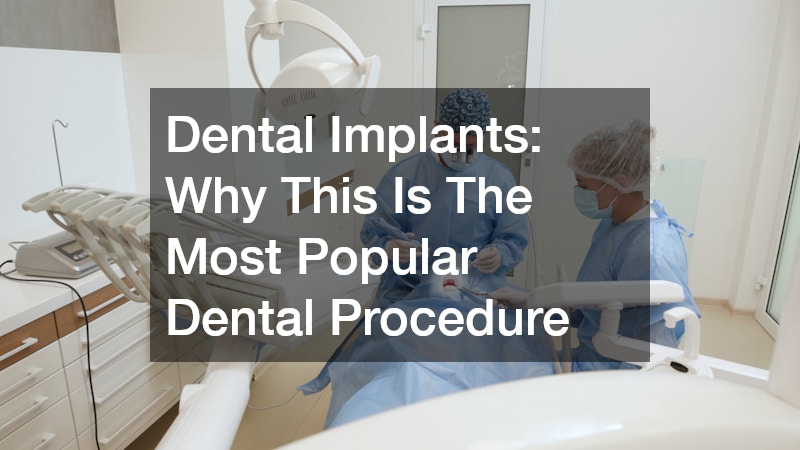
In recent years, dental implants have surged in popularity, becoming the go-to solution for people seeking a reliable and long-lasting way to replace missing teeth. Unlike traditional dentures or bridges, dental implants offer a permanent and natural-looking solution that restores both function and confidence. But what exactly makes this dental procedure so popular, and what can patients expect throughout the process?
What Are Dental Implants and How Do They Work?
Dental implants are artificial tooth roots that provide a strong foundation for replacement teeth. Unlike removable dentures, implants are surgically placed into the jawbone, where they integrate with the natural bone to mimic the stability and function of a real tooth.
They are designed to last for many years, making them a long-term solution for tooth loss.
Components of Dental Implants
A dental implant typically consists of three main components:
-
The Implant – A small titanium post that is surgically embedded into the jawbone.
-
The Abutment – A connector placed on top of the implant to support the crown.
-
The Crown – The visible part of the tooth, custom-made to match the color and shape of your natural teeth.
These components work together to create a secure, natural-looking tooth replacement.
How Dental Implants Function
Once the implant is placed in the jawbone, a process called osseointegration occurs, where the bone gradually fuses with the titanium post. This fusion provides a stable foundation for the abutment and crown, allowing patients to bite, chew, and speak just like they would with a natural tooth.
Types of Dental Implants
There are several types of dental implants to suit different needs. Endosteal implants are the most common and are placed directly into the jawbone. Subperiosteal implants sit on top of the jawbone but under the gum tissue, ideal for patients with insufficient bone height. Additionally, implant-supported bridges and dentures provide solutions for multiple missing teeth.
Advantages Over Other Dental Solutions
Dental implants stand out compared to other tooth replacement options. Unlike dentures, implants do not slip or require adhesives, offering better stability. Bridges, while fixed, often rely on neighboring teeth for support, which can compromise their integrity. Dental implants, in contrast, are independent and preserve the jawbone, preventing bone loss over time.
What Is the Procedure for Getting Dental Implants?
Initial Consultation
The first step in the dental implant process is a thorough consultation with a dental professional. During this visit, the dentist evaluates oral health, reviews medical history, and discusses the patient’s goals. X-rays or 3D scans may be taken to assess jawbone density and structure.
Pre-Implant Planning
Careful planning is crucial for successful implant placement. This stage involves creating a customized treatment plan, which may include bone grafting if necessary. Digital imaging ensures precise placement, maximizing both the aesthetic and functional outcomes.
Surgical Procedure
The surgical placement of the implant involves inserting the titanium post into the jawbone. This is typically performed under local anesthesia, ensuring comfort throughout the procedure. Depending on the patient’s needs, multiple implants may be placed simultaneously.
Post-Surgery Care and Healing
After surgery, patients may experience mild swelling or discomfort, which can be managed with prescribed medications and proper oral hygiene. The healing period, known as osseointegration, generally takes a few months, during which the implant fuses with the jawbone. Regular follow-ups are important to monitor progress.
Fitting the Crowns
Once healing is complete, the dentist attaches the abutment and custom-made crown to the implant. The result is a natural-looking, fully functional tooth that blends seamlessly with the surrounding teeth.
What Are the Benefits of Dental Implants?
Improved Oral Health
Dental implants contribute significantly to oral health. By replacing missing teeth, they prevent adjacent teeth from shifting and reduce the risk of gum disease and bone deterioration. Unlike bridges, implants do not require altering nearby teeth, preserving the natural structure.
Enhanced Aesthetics
Dental implants look and feel like natural teeth. They are custom-designed to match the shape, size, and color of surrounding teeth, restoring a patient’s smile and facial structure. This natural appearance is a major reason many people choose implants over other dental solutions.
Durability and Longevity
With proper care, dental implants can last a lifetime. The titanium posts are highly durable, and the crowns are resistant to staining and wear. This longevity makes implants a cost-effective investment in the long run, compared to temporary solutions like dentures.
Improved Functionality
Dental implants restore full chewing and speaking capabilities. Patients can eat a variety of foods without concern about slipping dentures or compromised bite strength. The stability of implants ensures comfort and confidence in daily activities.
Increased Confidence and Self-Esteem
Beyond functional benefits, dental implants have profound psychological effects. Restoring a full smile can boost self-esteem, enhance social interactions, and improve overall quality of life. Patients often report feeling more confident and less self-conscious after receiving implants.
Dental implants have earned their reputation as the most popular dental procedure due to their combination of functionality, durability, and aesthetic appeal. They provide a long-term solution for missing teeth while supporting oral health, improving appearance, and enhancing quality of life. From the initial consultation to the final crown placement, dental implants offer a reliable and transformative way to restore a healthy, confident smile.

